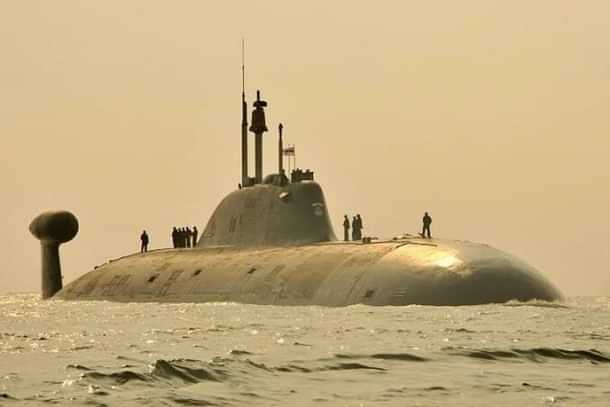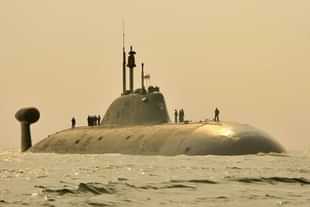Defence
Nuclear Submarines: Three New Developments Reveal How India's Sea-Based Deterrent Is Taking Shape
Prakhar Gupta
Oct 14, 2024, 02:41 PM | Updated Nov 13, 2024, 02:29 PM IST
Save & read from anywhere!
Bookmark stories for easy access on any device or the Swarajya app.


There are clear signs that the third and arguably the most crucial leg of India’s nuclear triad — its sea-based second-strike capability — is making impressive progress toward establishing credibility.
One, in a relatively low-profile ceremony held in late August at the Ship Building Centre in Visakhapatnam, INS Arighat, India’s second SSBN — a nuclear-powered submarine equipped with nuclear-tipped missiles — was officially commissioned into service.
Two, the government has finally given a go-ahead for a new nuclear-submarine building programme, under which India would indigenously build two SSNs — a nuclear-powered submarine equipped with conventional weapons.
And three, just weeks later, India is preparing to inaugurate a new facility that will ensure round-the-clock encrypted communication for submerged submarines on extended missions once it becomes fully operational in two to three years.
These events might look random at first, but they’re actually part of a bigger picture.
The commissioning of INS Arighat, for instance, holds greater significance than that of a usual second submarine of a class entering service.
INS Arighat is a clear upgrade over its predecessor, INS Arihant, India's first SSBN. The government, which usually remains tight-lipped about India's SSBN programme, has itself acknowledged that INS Arighat is "significantly more advanced."
While Arihant, which was commissioned in August 2016, mainly served as a technology demonstrator — despite being in active service — and had a sharp learning curve, Arighat takes all those lessons learned and technological advancements into account, especially since it joined the fleet in 2024, an eight-year gap.
Moreover, Arihant had at least one major accident, which pointed out areas for improvement, and Arighat has addressed those issues. All these factors make Arighat a more capable platform.
With its commissioning, it is clear that India's SSBN-building program has at least ironed out the early technical challenges; if it hasn't yet entered the assembly-line phase, the SSBNs following Arighat will feature major improvements.
In short, INS Arighat is a stepping-stone toward even more capable SSBNs.
The slightly bigger INS Aridhaman is expected to be commissioned next year. This 7,000-tonne vessel will be armed with K-4 submarine-launched ballistic missiles (SLBMs) that have a striking range of 3,500 km. Following the Aridhaman, an advanced SSBN codenamed S-4 will be introduced, along with another unnamed fifth SSBN, which will be equipped with the K-5 submarine-launched ballistic missile boasting a range of 5,000 km.
The government’s decision to greenlight the development of two nuclear-powered attack submarines (SSNs) shows its confidence in the SSBN program's progress. The plan is to build two 6,000-tonne submarines at the Ship Building Centre (SBC) in Visakhapatnam, with each costing around Rs 15,000 crore. Like the follow-on SSBNs, the knowledge gained from the early SSBN program will help with the SSN project, proving that the SSBN initiative is really making headway.
Additionally, the commissioning of INS Arighat has sparked speculation about its potential for long-range patrols armed with nuclear ballistic missiles. At least one report from Hindustan Times' Shishir Gupta, who has a knack for sniffing out what's happening inside India’s defence establishment, highlights this possibility.
However, there are some hurdles to overcome.
"A nuclear submarine usually has a system of negative control with de-mated missile systems and electronic locks (permissive action links) attached to the weapon system. The locks preclude arming and launching of the missiles without the insertion of a prescribed electronic discrete code by the command authority.
With cannisterised missiles on the Arihant, the warheads are supposedly pre-mated. It is for the submarine captain to launch a missile on explicit orders from the command authority. But communication with an SSBN is tricky because the very low-frequency systems in use on the submarine are prone to disruption at great depths," Abhijit Singh, a former naval officer who heads the Maritime Policy Initiative at ORF, explains.
For an Indian SSBN on patrol to launch its nuclear weapons at a target in China, it needs authorisation from India’s Nuclear Command Authority, headed by the Prime Minister. A reliable communication link between the command authority and the submarine is critical. This explains the significance of the very-low-frequency (VLF) transmitting station being set up at Vikarabad in Telangana, not far from where India’s nuclear submarine base in the Bay of Bengal, INS Varsha, is coming up.
INS Arihant conducted its first deterrence patrol in 2018. Four years later, in October 2022, the Ministry of Defence announced the successful launch of a submarine-launched ballistic missile in the Bay of Bengal by Arihant, achieved “with very high accuracy.” This milestone, along with the move towards the new VLF station, suggests that the command and control architecture for India's sea-based nuclear deterrent is maturing.
Prakhar Gupta is a senior editor at Swarajya. He tweets @prakharkgupta.





